Fix: Microsoft Excel is Trying to Recover Your Information
Microsoft Excel is trying to recover your information’ error occurs because of antivirus false positive, preview pane conflicts, conflicting applications, outdated Excel version, outdated Windows and corrupted Office installations. The user gets stuck in this error message for an indefinite period of time.
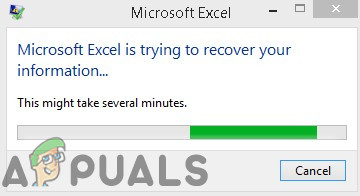
What Causes Microsoft Excel is Trying to Recover Your Information Error?
- False Positive by Anti-virus: Antivirus keeps your system safe from malicious attacks. Sometimes Excel or any of its Add-ins/Macros are detected as malware by antivirus (false positive) and the antivirus will restrict different required features of Excel and thus cause the current error.
- Preview Pane Conflicts: Excel is known to have issues with the preview pane functionality of File Explorer in Windows and this incompatibility can be the root cause of the current problem.
- Conflicting Applications: Certain applications conflict with the legitimate operation of Excel. If any of these applications are installed on your system then you may encounter the current problem.
- Outdated Excel Version: Microsoft releases frequent Excel updates to keep it bug-free and improve its functionality. If you are using an outdated version of Excel then you are inclined to face many problems including the one at hand.
- Outdated Windows: Frequent updates of Windows by Microsoft are quite essential for the proper operation of your system. If you are using an outdated Windows build then you are prone to many issues including the current one.
- Corrupted Office Installation: If Office/Excel installation has corrupted, then it can cause the current Excel error.
- Conflicting Add-Ins: Add-ins add great functionality to Excel. If there are corrupted add-ins or add-ins which are conflicting with the regular operations of Excel, then you may face the current problem.
- Incompatible Default Printer: Excel at startup communicates with the default printer of the system. If Excel cannot communicate with the printer or the default printer is not compatible with Excel, then it can force Excel into the current error.
- Corrupted User Files: Corrupted user files or wrong user configuration can cause Excel to show the current problem.
- Conflicting Macros: Macros are quite helpful in performing the repeated operations by the user. But the outdated or corrupted Macros can cause the current Excel error.
- Wrong Region Settings: Wrong region settings of your system or usage of not recommended Regional Format then you may face the current Excel problem
Pre-Requisites before proceeding to Solutions
- Check whether the issue is related to a single file or other files are showing the same error. If the problem is related to a single file, then try to open and repair that particular file. If the issue is a general one, then follow the solutions.
- If you are editing an Excel file stored on the network, then download the Excel file locally from the network and, then try to edit.
- Make sure no external links in the workbook either from formulas, range names, charts, shapes, hidden sheets or queries.
- Minimize the number of shapes in the file.
- Use only one workbook in Excel and run only one instance of Excel.
- File should not be password protected.
- If the file is generated by a third party application then the generated files may be corrupted. Test the generated files on another system outside the third-party application.
- If Microsoft Excel is in use by another process, this information will be displayed in the status bar at the bottom of the Excel window. If Excel is being used and another action is going on then, Excel may not respond. Let the running task to complete before attempting another action.
- Excel files can grow very large when a lot of shapes and formatting are added to it. In that case, you should make sure that the PC has enough memory/RAM to run the application. Try to open the problematic file on a PC with better specs. Also, make sure that your system meets minimum system requirements.
- Do not change any excel file name from File Explorer. Use Excel’s Save as command instead.
- If you have more than one graphics card, then use the graphics card which is not being used.
1. Temporarily Disable Your Antivirus Program
Antivirus application plays a vital role in the security of your system. Many anti-virus applications are known to have issues with Microsoft Excel by detecting it, Macros or any add-ins of Excel as malware and restricting their access to certain required features and thus cause the current error. In that case, disabling anti-virus temporarily may solve the problem.
- Turn off your Anti-virus.
- Launch Microsoft Excel and open the problematic files and check if Microsoft Excel has started to work properly.
- If it is working fine then you have to create an exception for the Excel or the problematic file in the antivirus or otherwise replace it with another non-conflicting antivirus application.
Warning: Change your antivirus settings at your own risk as this step makes your system vulnerable to fraudulent, viral or malicious attacks.
2. Disable the Preview Pane in File Explorer
For a better user experience, Windows has different panes like Preview pane, the Details pane, and the Navigation pane. Preview pane, as the name implies, is used to preview the contents of certain types of files while staying in File Explorer. For example, if you select an image file in File Explorer, you can see a preview of it; if you select an Excel file, you can also preview its contents. But Excel is known to have issues with this preview pane functionality. In that case, disabling Preview pane may solve the problem.
- Press Windows+ E to open File Explorer
- In the View tab, click on Preview Pane.
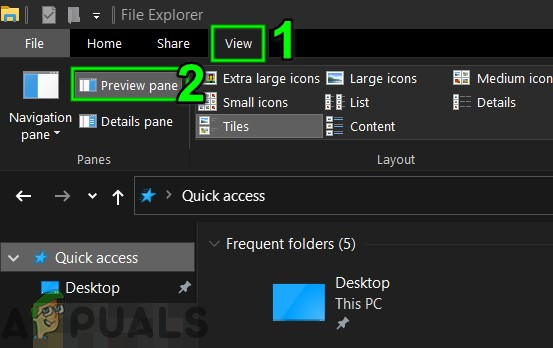
Disable Preview Pane - Open Excel and check if Excel is functioning without any problem.
3. Run Excel in Safe Mode
Your Excel might get stuck in the ‘recovering information’ Window because of certain add-ins and Excel startup settings. Excel has a built-in Safe Mode to open Excel without certain types of add-ins and startup settings. When Excel is launched in Safe Mode, it will bypass functionality and settings like changed toolbars, alternative startup location, the xlstart folder, and Excel add-ins (COM add-ins are excluded).
- Press Windows+ R to open the Run command box.
- In the Run command box type and then click Ok,
excel.exe/safe
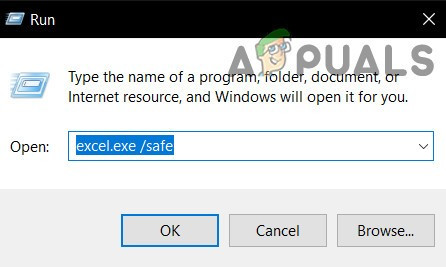
Now check if Excel has started to operate normally. If so, then try to find out the problematic Excel Setting that is causing the issue either by disabling add-ins or repairing Excel.
4. Disable Excel Add-ins
Excel add-ins add a great deal of functionality to it. However, sometimes, poor written add-ins or add-ins written for an older version of Excel start to interfere in the regular operation of Excel and thus goes in an endless loop of ‘trying to recover your information’. In that case, disabling Excel add-ins may solve the problem.
- Open the problematic Excel file. If you can not open Excel then boot the system into Safe Mode or launch Excel in Safe Mode.
- Click on the File menu and then click on Options.
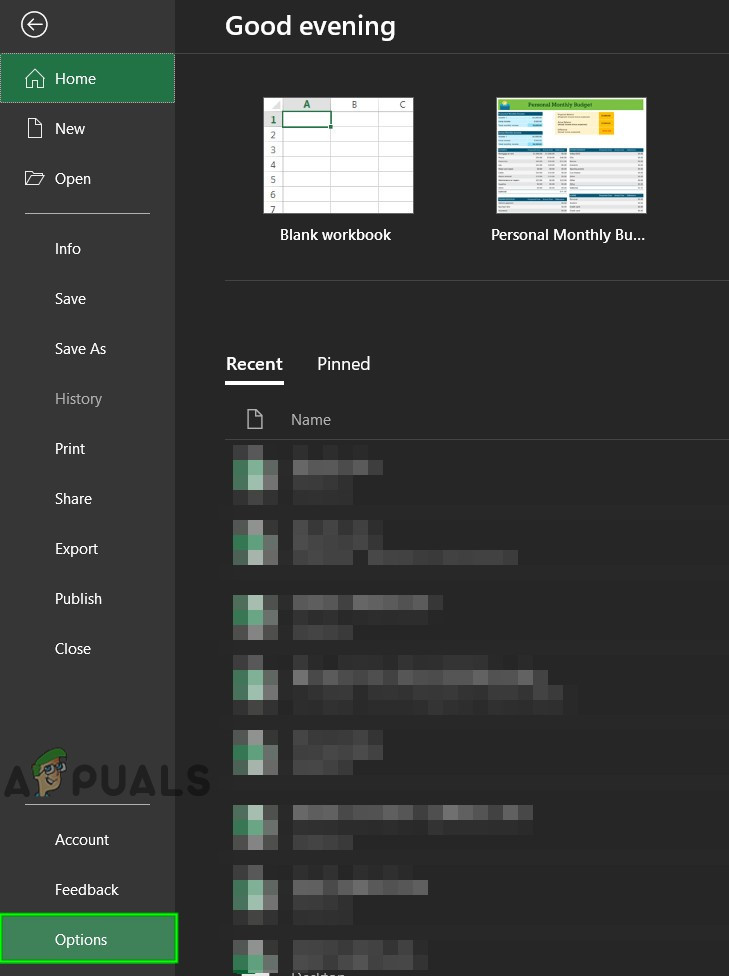
Open Excel Options - Click on Add-ins and then in the Manage dropdown box select the type of add-ins you want to disable for example click on Excel add-ins and then click on the Go
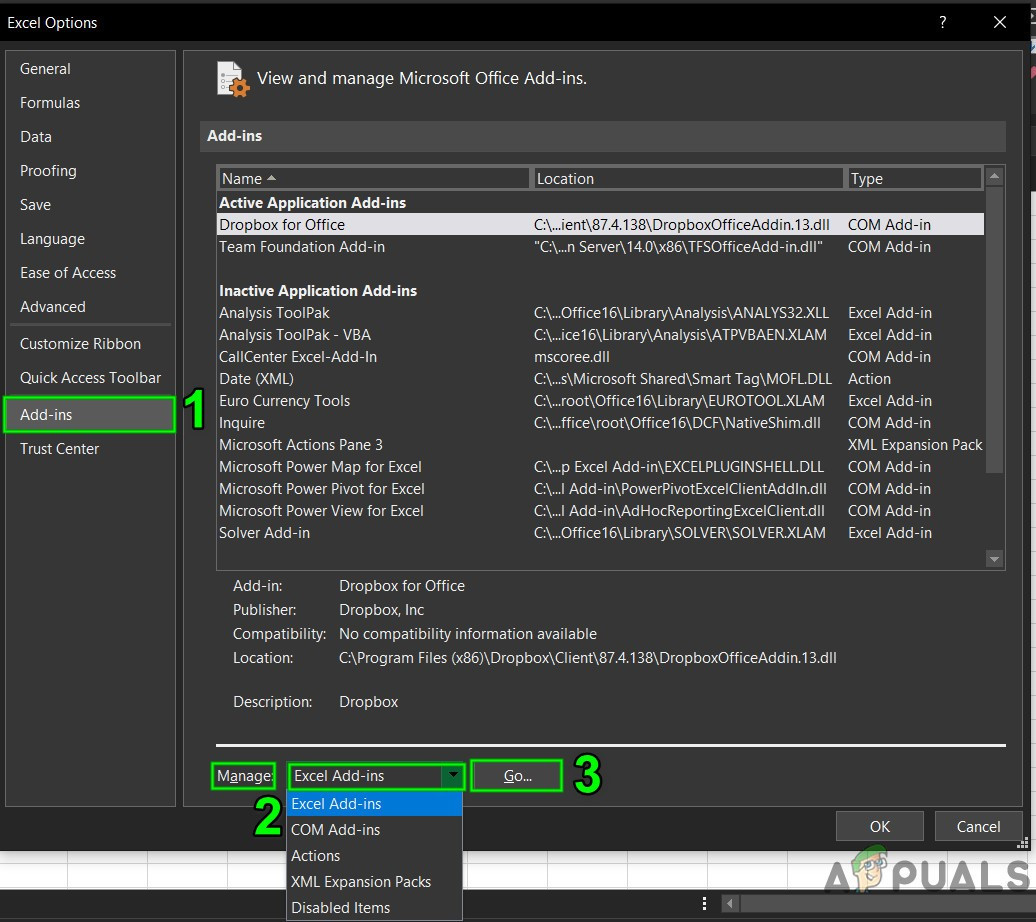
Manage Excel Add-ins - Uncheck all boxes and click OK
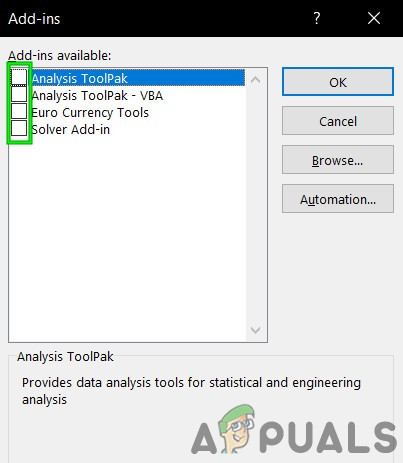
Uncheck all Add-ins - Now save and close the file and reopen
- Now check if Excel has started to perform normally. If so, then enable the add-ins one by one and restart Excel after each enabling of add-in till you single out the problematic add-in and then keep that add-in disabled. Then look and install the updated version of that problematic add-in.
5. Tweaks with Macros
A macro is a sequence of instructions that Excel executes when you tell it to. The possibilities of Macros are endless. Sometimes Macros conflict with the operation of Excel and cause trouble with its normal operations. For troubleshooting purposes, we can recompile the Macros and see if it solves the problem.
- Open Excel and then press Alt+F11 to open Microsoft Visual Basic for Applications.
- Now on the menu bar, click on Tools menu and then in the drop-down menu click on Options.
- Now in the Options window, click on the General tab and uncheck the option “Compile on Demand” and press Ok.
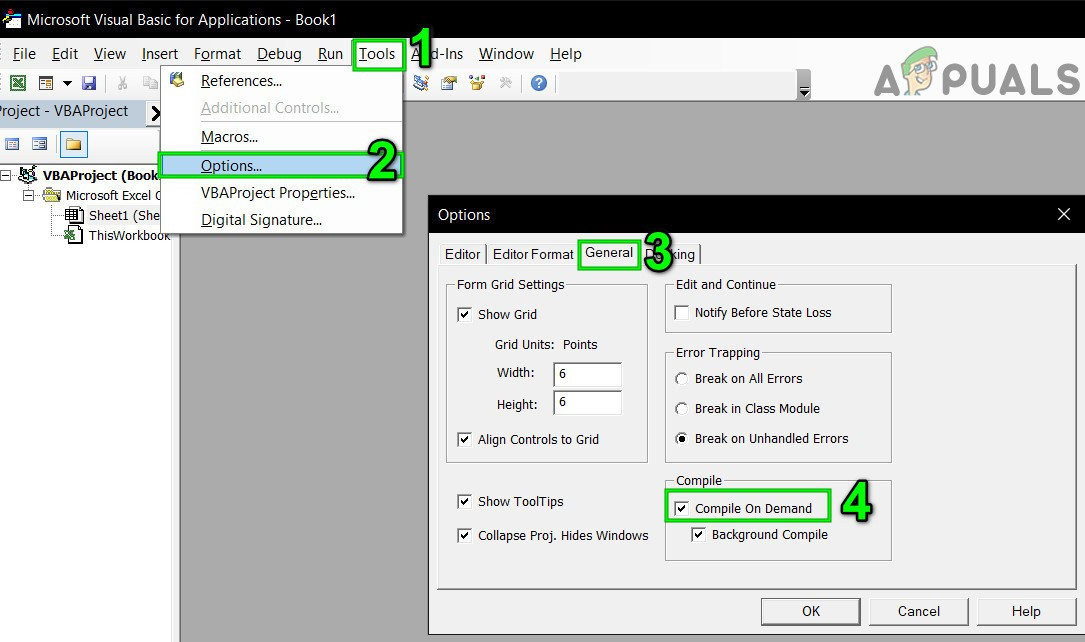
Uncheck Compile on Demand - Now in the Visual Basic, click the Insert menu and then click on Module.
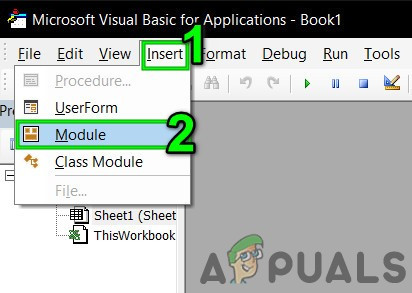
Insert New Module in Visual Basic - Now click on the Debug menu and click on Compile VBA Project.
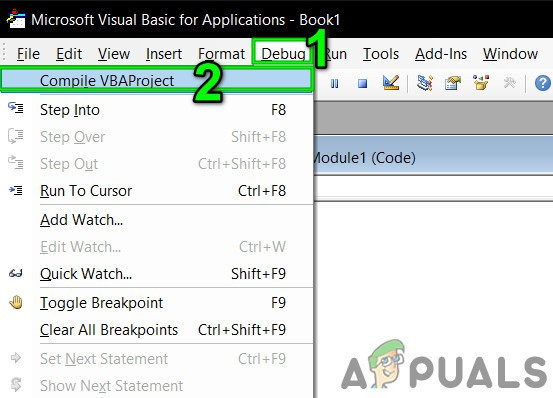
Compile VBA project - Now click on the File menu and click on Save.
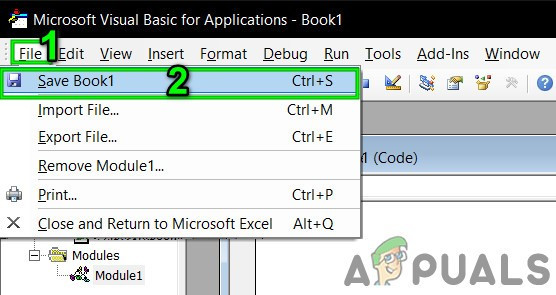
Save the VBA File - Now click on the File menu and then click on Close and Return to Microsoft Excel.
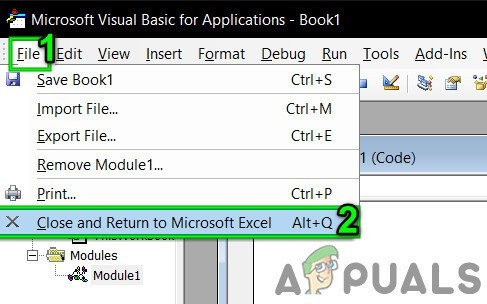
Close and return to Microsoft Excel - Save and close the file and Excel.
- Now reopen Excel and then check if Excel has started to function normally.
6. Disable Macros
Macros developed for the older versions of Excel can sometimes have compatibility issues with Excel and the application security can force Excel to go into the endless loop under discussion. In that case, disabling the Macros may solve the problem.
- Open Excel. If you cannot open Excel normally then use Excel in safe mode.
- Click the File menu and then click on Options.
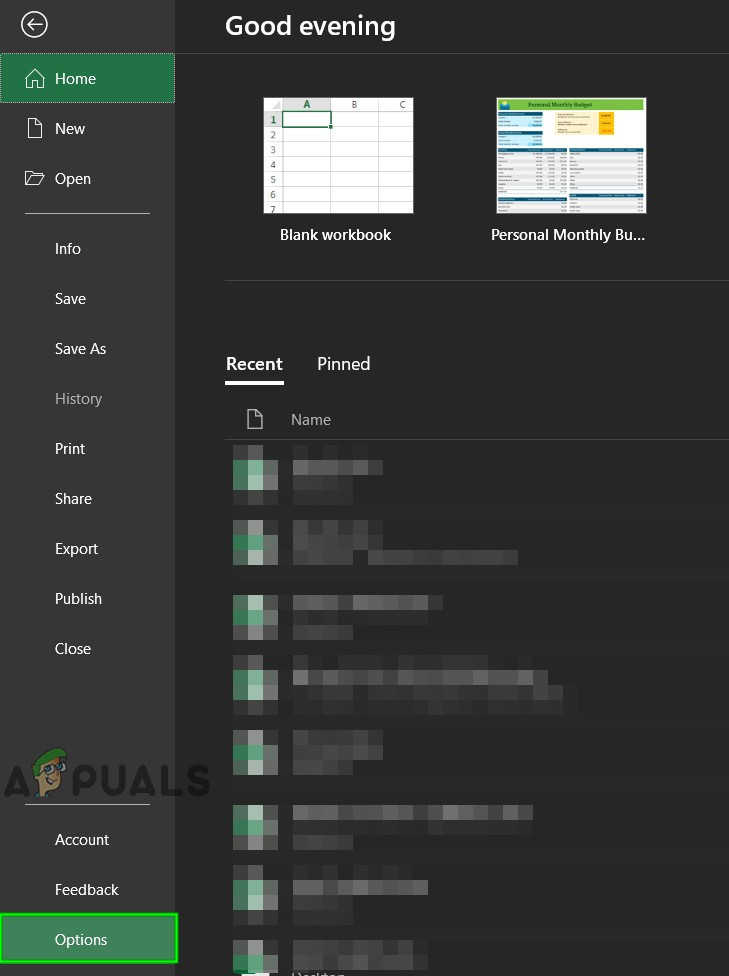
Open Excel Options - In the left pane of Window Click on Trust Center and then in the right pane of the window, click on Trust Center Settings.
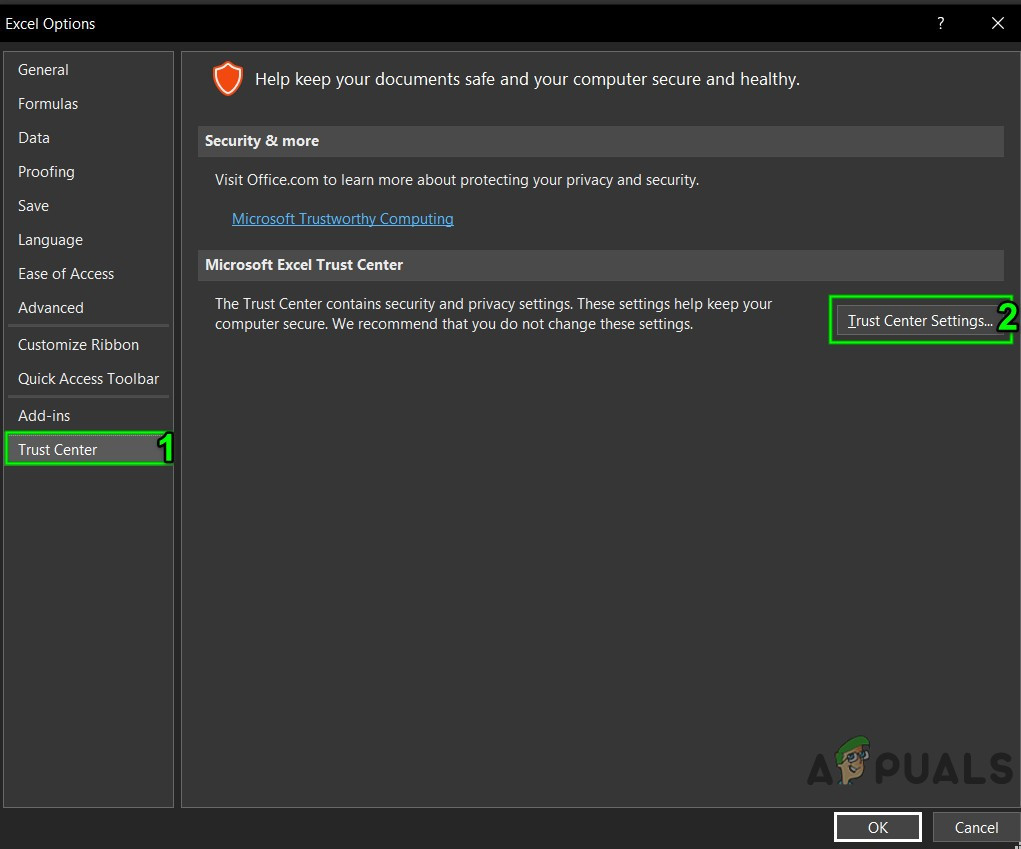
Trust Center Settings - Click on Macro Settings and then click on Disable all macros without notification.
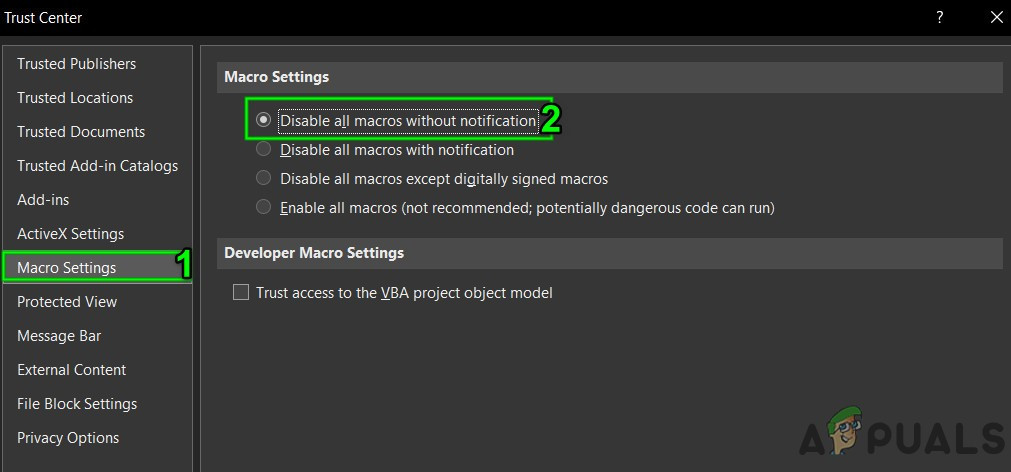
Disable All Macros without Notification - Now click on Trusted Documents and Uncheck Allow Documents on a Network to be trusted and check on Disable Trusted Documents and click Ok.
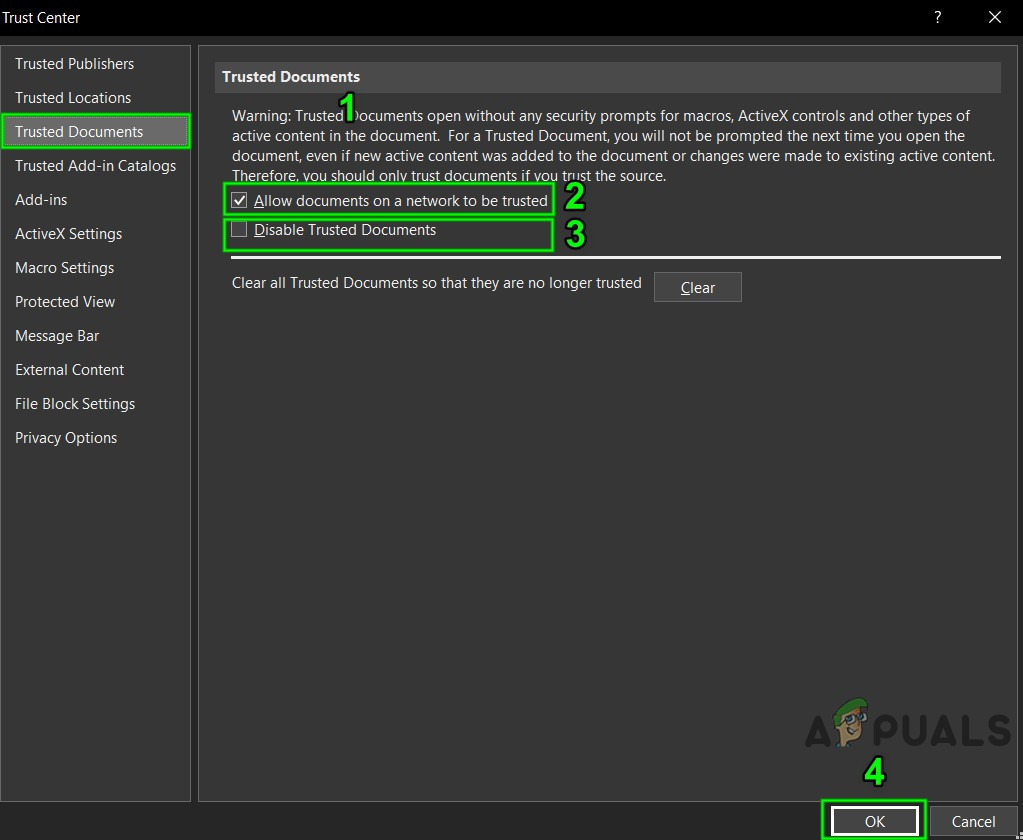
Disable Trusted Documents - Save and close the file and Excel.
- Open Excel and check if Excel has started to function properly.
7. Change the Default Printer
When Excel starts up, it communicates with your system’s default printer. And if this communication fails, Excel sometimes go in the endless loop of ‘Trying to recover your information’. In that case, changing the default printer may solve the problem. You can use any printer as default but a soft printer like Microsoft XPS Document Writer is recommended for testing purposes.
- Exit Excel
- Press the Windows button and type Printers and in the resulting list click on Printers & Scanners.
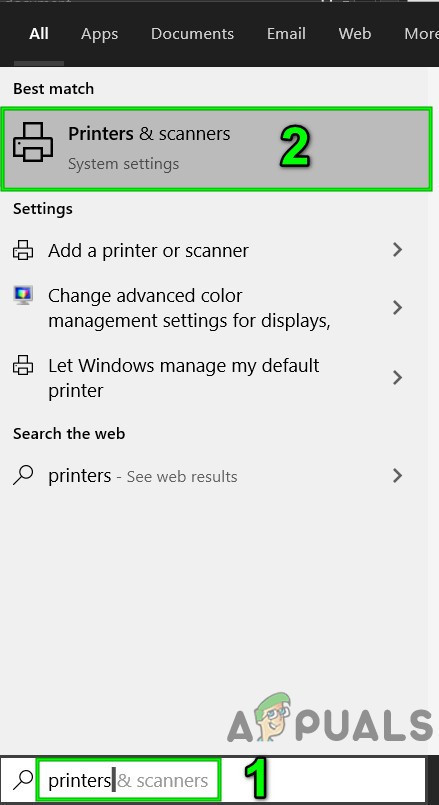
Open Printer & Scanners - Now in Printers & Scanners windows, click on “Microsoft XPS Document Writer” and then click on Manage.
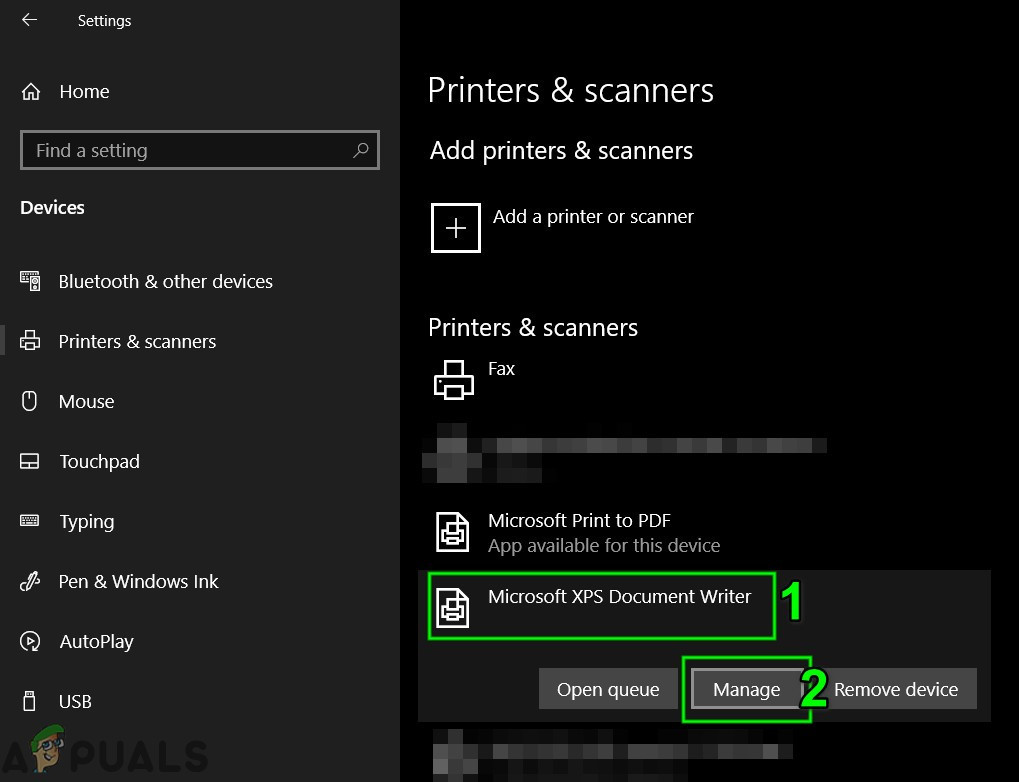
Manage Microsoft XPS Document Writer - Now in Microsoft XPS Document Writer management window, click on Set as default.
- Now open Excel and check if Excel has started to function normally.
8. Change Region Settings and Regional Format
If the region and language settings are different from your actual location and Regional Format is not as per the recommended one, then it can cause Excel to go into the endless loop. In that case, correcting the region and using the recommended Regional Format may solve the problem.
- Press Windows key and type Region and in the resulting list click on Region Settings.
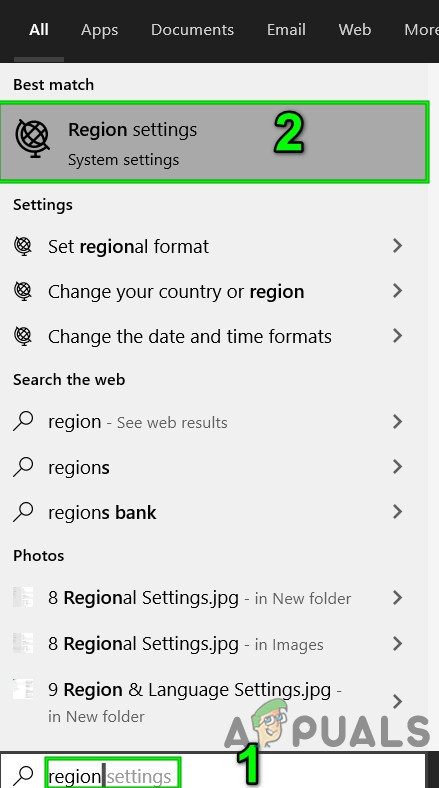
Open Region Settings - Now in the right pane of the window, select Country or region which matches your location.
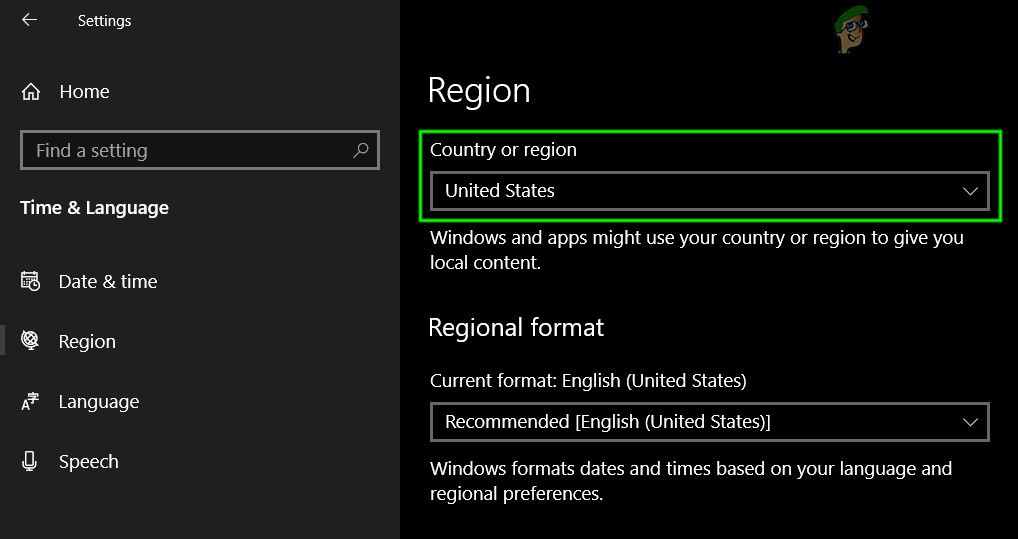
Change Country or Region as per your location - Now under the Regional Format, select the option which has Recommended with it.
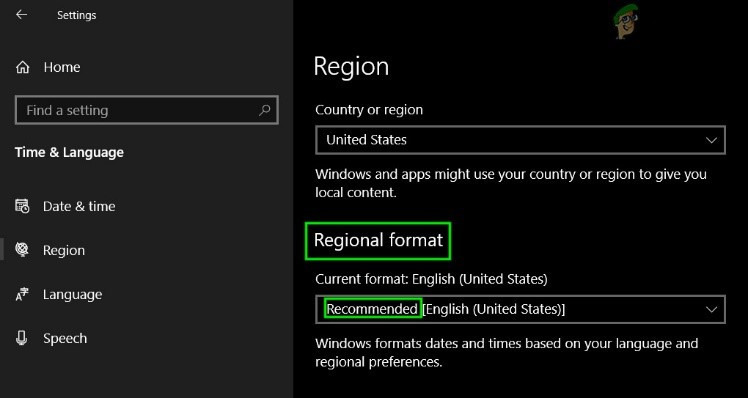
Change Regional Format to Recommended - Now restart the system.
- After the system is restarted, launch Excel and check if Excel has started to work normally.
9. Update Microsoft Excel to the Latest Version
Microsoft releases new updates for Excel to improve performance, add new features and fix bugs in Excel. If you are using an outdated version of Excel, it can cause trouble with normal operations of Excel which includes the situation under discussion. In that case, updating Excel may solve the problem.
- Open Microsoft Excel and click on the File tab.
- Select Account and then click on Update Options
- Now click Update Now
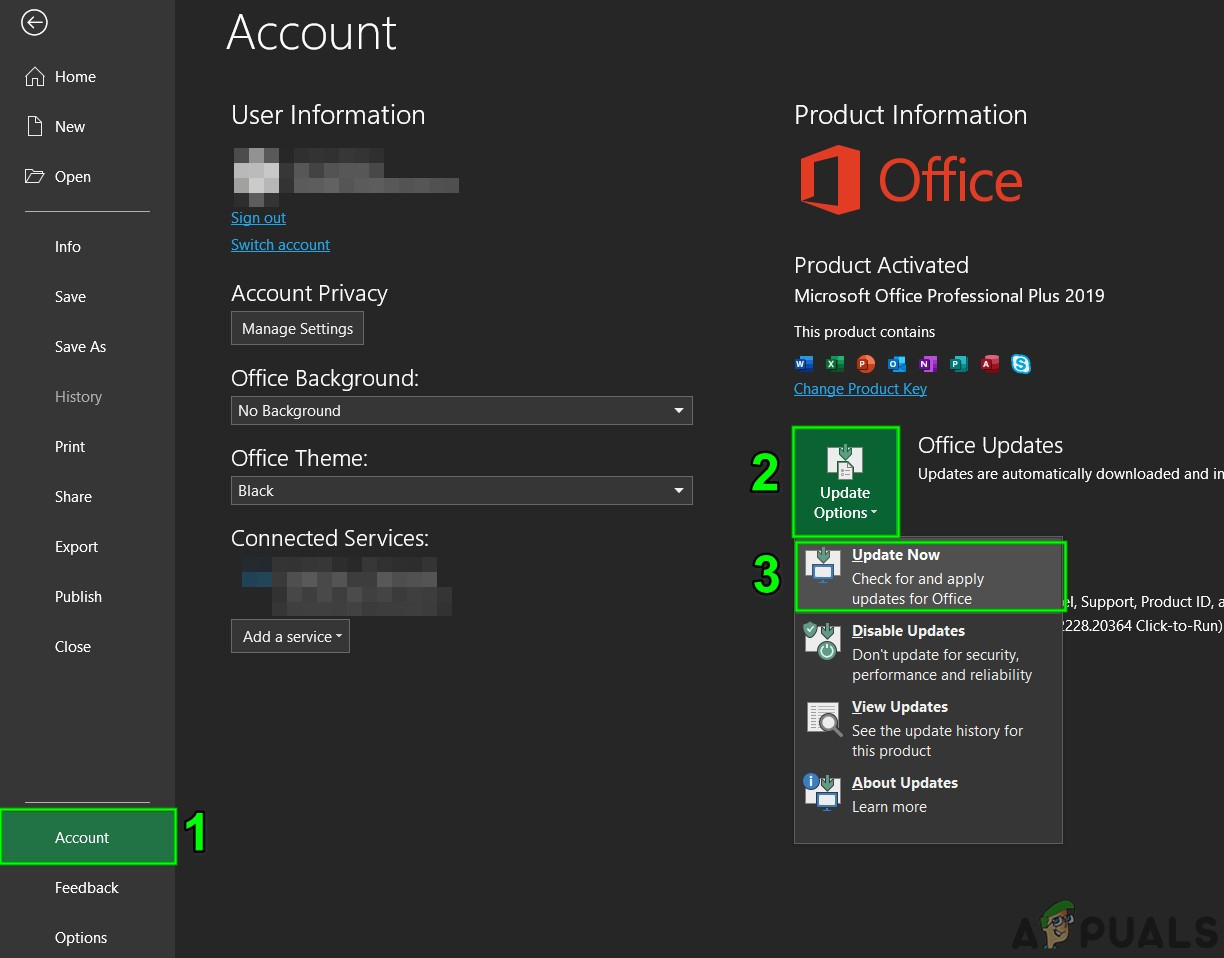
Update Microsoft Excel - Let the updates complete.
- Restart your PC and launch Excel and check if Excel has started to operate normally.
10. Update Windows to the Latest Version
Microsoft frequently releases Windows updates to improve Windows, add new features to it and to patch software/hardware loopholes. Outdated Windows versions are known to cause several problems with Excel itself. In that case, updating Windows to the latest version may solve the problem.
- Press Windows key and type updates.
- In the resulting list, click on Check for Updates.
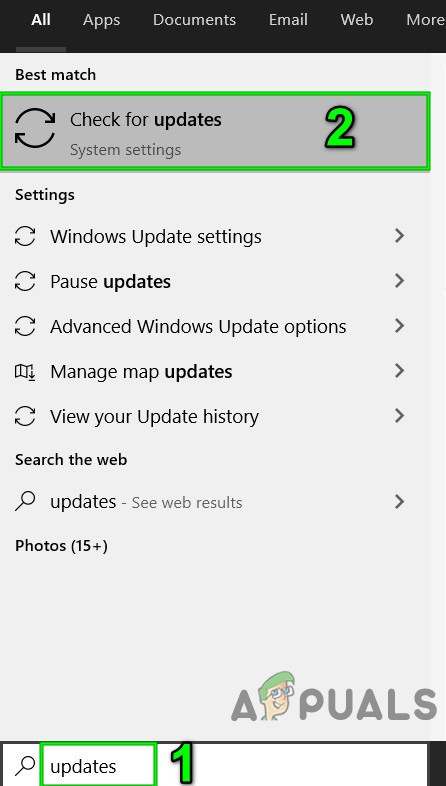
Check For Updates in Windows Search - Now in the Windows Update, click on Check for Updates.
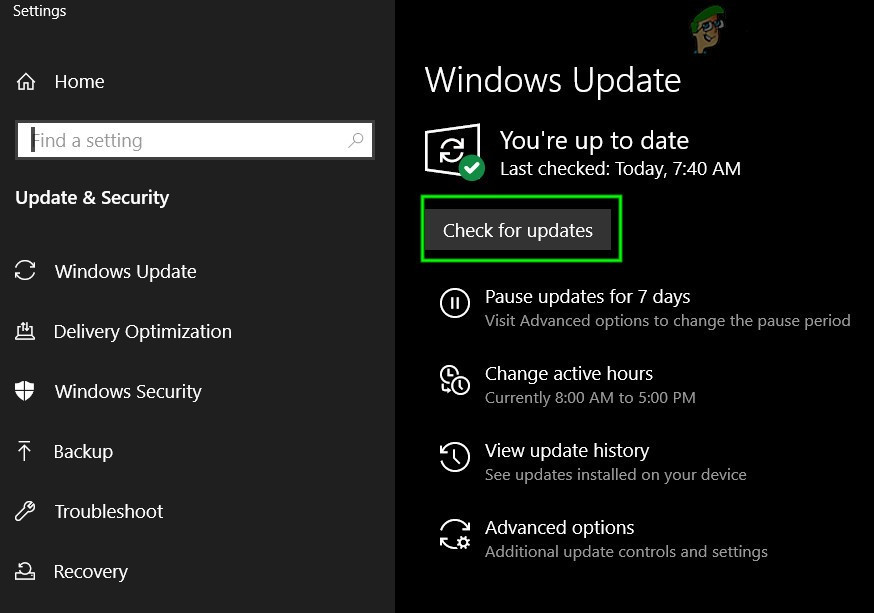
Check for Updates in Windows Update - After completion of updates, Restart the system.
- After the system is restarted, open the Excel and check if Excel has started to function properly without any problem.
11. Use Safe Mode or Clean Boot Windows
When Windows is started, several applications and services start automatically and then run in the background. These applications and services can interfere with the regular operation of Excel and cause unexpected issues (they conflict with the mechanics involved in running Excel). You can boot your system into Safe Mode or clean boot Windows to check if there are any conflicting application exists.
- Boot system into Safe Mode or Clean Boot Windows.
- Launch Excel and open problematic file.
Now check if Excel has started to function normally.
12. Create a New User Account
Conflicting user configurations or corrupted user files can force the user to face the endless loop of Excel is trying to recover your information. Here, creating a new user with administrator privileges may solve the problem.
- Create a new local administrator account.
- Navigate to the following path
c:\windows\temp.
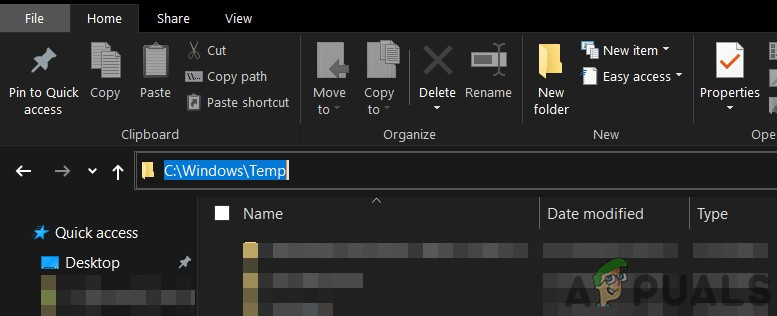
Open Windows Temp Folder - Press Ctrl+A to select all the items of the folder and press Shift+Delete to delete all the items (do not worry! You will not be able to delete some of the items, ignore them).
- Restart the system and then launch Excel and check if Excel has started to operate properly.
13. Repair Microsoft Office/Excel
If none of the above methods work, there is a high probability that your Excel installation itself is somehow corrupt or has missing files. Running the Microsoft Office built-in repair tool will clear any issues with the installation and thus may clear the problem.
- Press the Windows button and type Control Panel.
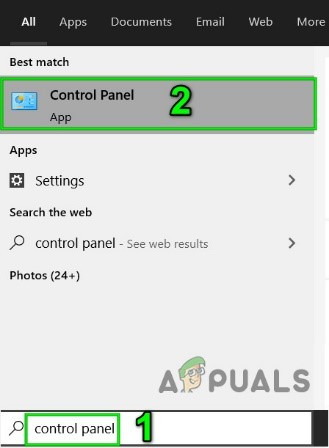
Open Control Panel - Click Programs.
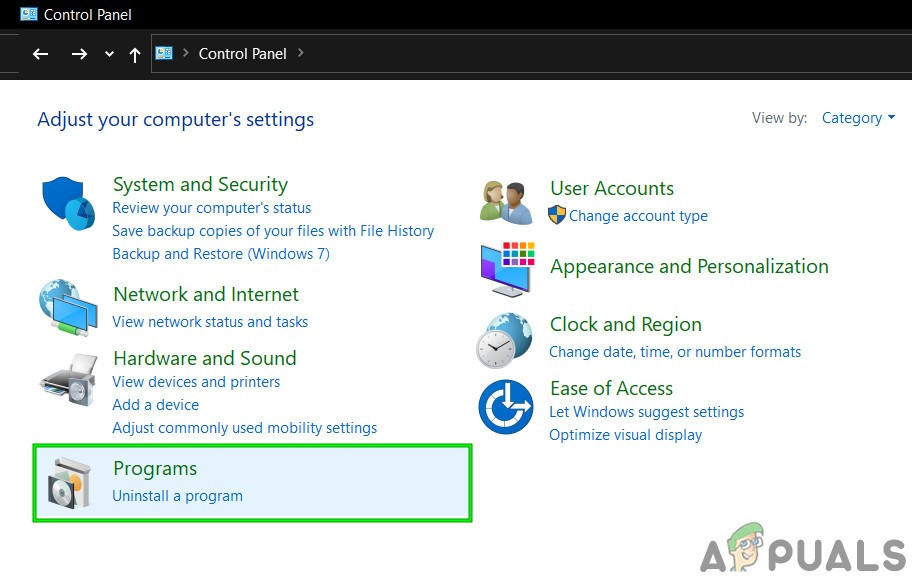
Open Programs - Now click on Programs and Features.
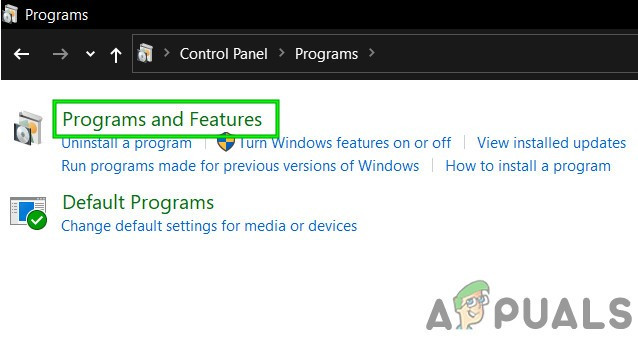
Open Programs and Features - Click the Office you want to repair, then click Change.
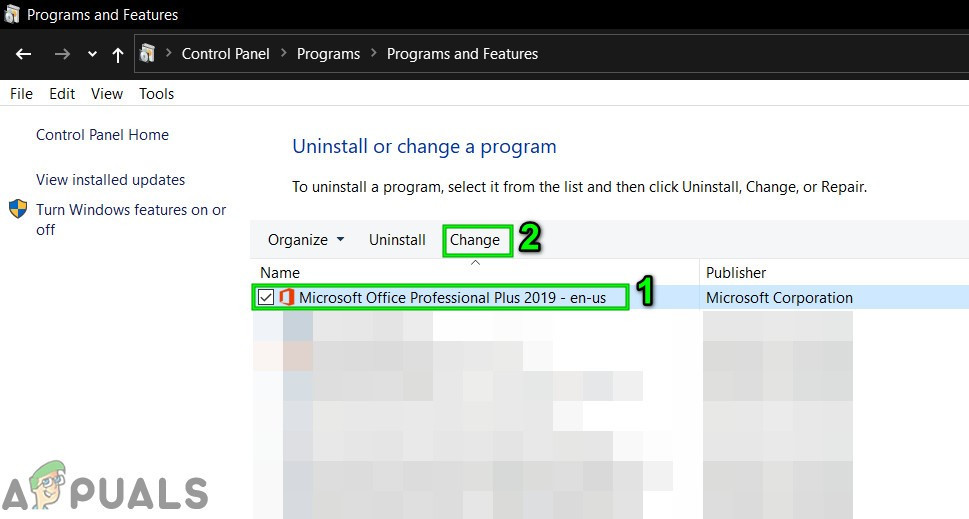
Click Change Microsoft Office - If UAC prompts, click yes.
- Now select Quick Repair and click Ok.
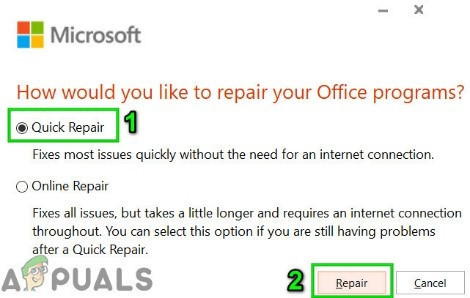
Quick Repair Office - Click Repair, then click Continue.
- Wait for the completion of the repair process and then restart your computer. And check if Excel has started to function properly.
- If not, then repeat step-1 to step-5.
- Now in Control Panel, select Online Repair and click Ok.
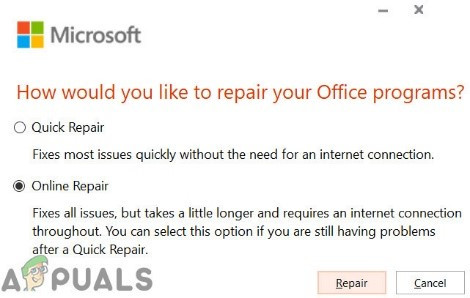
Online Repair Office - Click Repair, then click Continue.
- Wait for the completion of the repair process and then restart your computer.
- Launch Excel and check if Excel is operating without any problem.
Note: This will repair the whole Office suite even if you want to repair just Excel. If you have a standalone version of Excel, then in the control panel search for Excel by name and repair it following the above steps.
Hopefully, now you can use Excel without any problem. If you still are facing the problem, then try to uninstall and reinstall Excel. Also, if you are using the 64-bit version of Excel then try using the 32-bit version of Excel to see if it helps.





